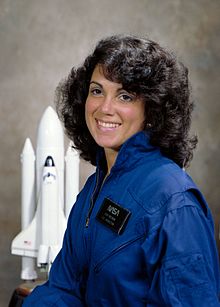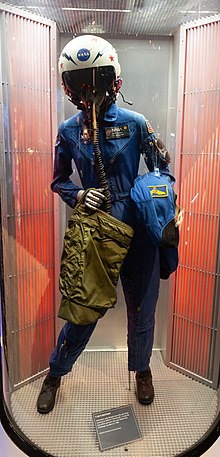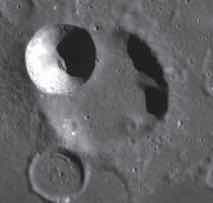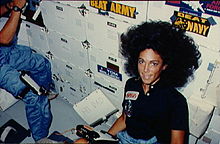Judith Resnik
Judith Resnik | |
|---|---|
 Resnik in September 1978 | |
| Born | Judith Arlene Resnik April 5, 1949 Akron, Ohio, U.S. |
| Died | January 28, 1986 (aged 36) Cape Canaveral, Florida, U.S. |
| Resting place | Arlington National Cemetery |
| Nationality | American |
| Alma mater | Carnegie Mellon University, B.S. University of Maryland, Ph.D. |
| Occupation | Engineer |
| Awards | |
| Space career | |
| NASA astronaut | |
Time in space | 6d 00h 56m |
| Selection | 1978 NASA Group |
| Missions | STS-41-D, STS-51-L |
Mission insignia |  |
Judith Arlene Resnik (/ˈrɛznɪk/; April 5, 1949 – January 28, 1986) was an American electrical engineer, software engineer, biomedical engineer, pilot and NASA astronaut who died aboard the Space Shuttle Challenger when it was destroyed during the launch of mission STS-51-L. Resnik was the second American woman in space and the fourth woman in space worldwide, logging 145 hours in orbit. She was the first Jewish woman of any nationality in space. The IEEE Judith Resnik Award for space engineering is named in her honor.
Judith Resnik was accepted at Carnegie Mellon after being 1 of only 16 women in the history of the United States to have attained a perfect score on the SAT exam at the time. She went on to graduate with a degree in electrical engineering from Carnegie Mellon before attaining a Ph.D. in electrical engineering from the University of Maryland. Recognized while still a child for her "intellectual brilliance,"[2] Resnik went on to work for RCA as an engineer on Navy missile and radar projects, was a senior systems engineer for Xerox Corporation and published research on special-purpose integrated circuitry before she was recruited by NASA to the astronaut program as a mission specialist at age 28. While training on the astronaut program, she developed software and operating procedures for NASA missions.[3] She was also a pilot and made research contributions to biomedical engineering as a research fellow of biomedical engineering at the National Institutes of Health.
Early life[]
Judith Resnik was born in 1949 to Sarah and Marvin Resnik, an optometrist, in Akron, Ohio. Her father was fluent in eight languages and served in the Army in military intelligence and aerial reconnaissance during World War II in the Pacific Theater.[4] Both her parents were Jewish immigrants originally from Ukraine, (her father having immigrated via Israel).[5] She grew up in an observant Jewish home in a family of rabbinical descent, studying at Hebrew school every weekend and celebrating her Bat Mitzvah.[6] Her parents divorced while she was a teenager; in response, she prepared and filed a court case so that her custody could be switched from her mother to her father, with whom she was particularly close.[7]
Resnik was noticed for "intellectual brilliance" while still in kindergarten and entered elementary school a year early.[8] At Firestone High School, she was an outstanding student, excelling in mathematics, languages and classical piano.[9] She graduated as valedictorian and runner-up homecoming queen.[10] Playing classical piano with "more than technical mastery", she planned on becoming a professional concert pianist.[11] When questioned about her intensity at the piano, she replied, "I never play anything softly".[12] Before college, she attained a perfect score on her SAT exam,[13] the only woman in the country to do so that year and one of only 16 women at that time to ever have done so.[14]
She entered Carnegie Mellon at age 17 and ultimately was one of three female students in electrical engineering. In her second year at Carnegie Tech, she developed a passion for electrical engineering, discovering her interest in "practical aspects of science" after attending lectures with her boyfriend and future husband, Michael Oldak, who was on the engineering course.[15] Oldak said, "She was a math whiz, but at some point math lost the numbers and she wanted something more tangible so she switched her collegiate major to electrical engineering".[16] She earned a B.S. degree in electrical engineering in 1970.[17] Her mentor and advisor was the dean of the Carnegie Mellon College of Engineering, Professor Angel G. Jordan.[18] In 1977 she earned a Ph.D. in electrical engineering with honors at the University of Maryland.
Career[]
Engineering[]
Upon graduation from Carnegie Mellon, Resnik worked at RCA as a design engineer in missile and radar projects[19] and won the Graduate Study Program Award. She performed circuit design for the missile and surface radar division. While at RCA, she worked for the Navy building custom integrated circuitry for the phased-array radar control systems and later developed electronics and software for NASA's sounding rocket and telemetry systems programs. An academic paper she wrote on special purpose integrated circuitry caught the attention of NASA during this time.[20]
In 1977, Resnik qualified as a professional aircraft pilot while completing her Ph.D., having achieved near perfect scores in her flying exams (two 100s and a 98).[21] After joining NASA, she piloted the Northrop T-38 Talon. Astronaut Jerome Apt described her as “an excellent pilot and a superb operator in space”.[22]

While working on her doctorate, Resnik also worked as a research fellow of biomedical engineering at the Laboratory of Neurophysiology at the National Institutes of Health. As a biomedical engineer, Resnik researched the physiology of visual systems.[23] An academic article she published in 1978 concerned the biomedical engineering of optometry ("A novel rapid scanning microspectrophotometer and its use in measuring rhodopsin photoproduct pathways and kinetics in frog retinas").[24] She was a senior systems engineer for Xerox Corporation in product development.[25]
NASA Astronaut Corps[]
In January 1978, Resnik was recruited at age 28 into the NASA Astronaut Corps, one of six women selected out of 8,000 applicants.[26] The program to find women astronauts was developed by actress Nichelle Nichols, who volunteered her time.[27][28] Her mentor and advisor, Professor Angel G. Jordan, then Dean of Carnegie Mellon College of Engineering and later provost of Carnegie Mellon, encouraged Resnik to apply for the program. Jordan later regretted doing so, saying 25 years after the Challenger disaster, “She was an amazing person... I pushed her to excel, and I live with that memory every day."[29]
On joining NASA's astronaut program, Resnik trained intensely and with great determination, focusing particularly on her physical fitness. She was deeply disappointed when she didn't become the first American woman in space.[30] During training, it was assumed that either Resnik or Sally Ride would become the first woman in space, as they were the only female trainees receiving "the sorts of technical assignments which really prepared them for flight", such as RMS work and CAPCOM duties.[31]
Resnik's first space flight was on the maiden voyage of Discovery from August to September 1984 as a mission specialist. Her duties included operating the shuttle's robotic arm,[32] which she helped create and on which she was an expert. She deployed and conducted experiments on a solar array wing as a potential future way of generating additional electrical power during space missions. After performing numerous dynamic tests, Resnik concluded that the experiment was very well-behaved and matched ground simulations of the array.[33] She advocated the benefits of the solar array technology, particularly for future use in powering space stations.[34]
During the mission, Resnik held a written sign saying "Hi Dad" to the cameras, and in a live televised broadcast told President Reagan, "The Earth looks great". When Reagan asked her if the flight was all she hoped it would be, she replied, "It certainly is and I couldn't have picked a better crew to fly with."[35] Henry Hartsfield described Resnik as the "astronaut's astronaut" after the mission,[36] while Mike Mullane wrote, "I was also happy to be crewed with Judy... She was smart, hardworking, and dependable, all the things you would want in a fellow crewmember."[37]

While undergoing the intensive training of the NASA astronaut program, Resnik worked for NASA on research into the principle of orbital systems, flight software and the development of systems of manual control of spacecraft. She developed the software and operating procedures for the Remote Manipulation System for NASA. In addition, she developed the deployment systems for the tethered satellite system[38] as well as working on orbiter development and creating experimental software for NASA to use on its missions.[39]
Resnik was the second American woman in space, after Sally Ride, and fourth overall.[40] She was also the first American Jewish astronaut to go into space, the first Jewish woman and at the time only the second Jew to go to space (after Boris Volynov of the Soviet Union).[41]
Challenger disaster[]
Resnik was a mission specialist aboard Challenger for flight STS-51-L.[42][43][44] Her last recorded words aboard Challenger regarded scanning for "LVLH" (low-vertical/low-horizontal), reminding the cockpit crew of a switch configuration change.[45]
Following the Challenger disaster, examination of the recovered vehicle cockpit revealed that three of the crew members' Personal Egress Air Packs were activated: those of Resnik, mission specialist Ellison Onizuka and pilot Michael J. Smith. The location of Smith's activation switch on the back of his seat means either Resnik or Onizuka likely activated it for him. Mike Mullane writes:
"Mike Smith’s PEAP had been turned on by Judy or El, I wondered if I would have had the presence of mind to do the same thing had I been in Challenger's cockpit. Or would I have been locked in a catatonic paralysis of fear? There had been nothing in our training concerning the activation of a PEAP in the event of an in-flight emergency. The fact that Judy or El had done so for Mike Smith made them heroic in my mind. They had been able to block out the terrifying sights and sounds and motions of Challenger's destruction and had reached for that switch. It was the type of thing a true astronaut would do—maintain their cool in the direst of circumstances."[46]
This is the only evidence available that shows Onizuka and Resnik were alive after the cockpit separated from the vehicle. If the cabin had lost pressure, the air packs alone would not have sustained the crew during the two-minute descent.[47] Resnik's was the first body to be recovered from the crashed vehicle cockpit by Navy divers of the USS Preserver.
Personal life[]
In 1970, Resnik married Michael Oldak, a fellow engineering student at Carnegie Mellon. They divorced in 1975 and remained on good terms. While at university, Resnik was a member of Tau Beta Pi and Alpha Epsilon Phi. She was a gourmet cook and a navigator in sports car rallies, in which she took part many times with her boyfriend.[48]
Legacy[]


Resnik has been awarded numerous posthumous honors and honored with landmarks and buildings being named for her, including a lunar crater Resnik located within the Apollo impact basin on the far side of the Moon; a dormitory at her alma mater, Carnegie Mellon; the main engineering lecture hall at the University of Maryland; Judy Resnik Drive in Randolph, NJ; Judith A. Resnik Elementary School in Gaithersburg, Maryland; Judith Resnik Community Learning Center in her hometown of Akron, Ohio; and Judith A. Resnik Middle School, established in 2016, in San Antonio, Texas.[49] A memorial to her and the rest of the crew of Challenger was dedicated in Seabrook, Texas, where Resnik lived while stationed at the Johnson Space Center.
The IEEE Judith A. Resnik Award was established in 1986 by the Institute of Electrical and Electronics Engineers and is presented annually to an individual or team in recognition of outstanding contributions to space engineering in areas of relevance to the IEEE.[50] The Society of Women Engineers (SWE) awards the Resnik Challenger Medal annually to a woman who has changed the space industry, has personally contributed innovative technology verified by flight experience and will be recognized through future decades as having created milestones in the development of space as a resource for all humankind.[51]
The Challenger Center was established in 1986[52] by the families of the Challenger crew, including Resnik's brother, Charles Resnik MD,[53][54] in honor of the crew members. The goal of the center is to increase STEM interest in children.
On February 23, 1990, Resnik was named one of ten finalists to represent Ohio in the National Statuary Hall in the U.S. Capitol in Washington, D.C.[55]
In fiction and nonfiction[]
Resnik has been portrayed in works of nonfiction and fiction, including the 1990 made for TV movie Challenger, where Julie Fulton portrayed her.
Resnik features prominently in Mike Mullane's 2006 book on the space program, Riding Rockets, which recalls Resnik's time in the NASA Astronaut Corps. Mullane was a colleague of Resnik and fellow crewmember on Discovery.
Resnik is featured in the 2020 Netflix Limited Series Challenger: The Final Flight, as one of the seven crew members aboard STS-51L, the fatal flight of Space Shuttle Challenger.
Further reading[]
- Riding Rockets: The Outrageous Tales of a Space Shuttle Astronaut Publisher: Scribner ISBN 0-7432-7682-5
See also[]
- List of female astronauts
- List of Jewish astronauts
- Space Shuttle Challenger disaster
- History of the Jews in Houston
References[]
![]() This article incorporates public domain material from websites or documents of the National Aeronautics and Space Administration.
This article incorporates public domain material from websites or documents of the National Aeronautics and Space Administration.
- ^ Jacobs, Bob; Mahone, Glenn (23 July 2004). "Challenger Crew Honored With Congressional Space Medal Of Honor". Headquarters; Washington: NASA. Retrieved 15 November 2020.
- ^ Women Spacefarers: Sixty Different Paths to Space By Umberto Cavallaro, Springer 2017, page 28
- ^ Women Spacefarers: Sixty Different Paths to Space By Umberto Cavallaro, Springer 2017, page 29
- ^ Mar 18, 2010 Marvin Resnik, father of Challenger astronaut Judith Resnik, was 90, Mar 18, 2010
- ^ Judith Resnik (1949 - 1986) Jewish Virtual Library
- ^ The Epic Flight of Judith Resnik, by Scott Spencer and Chris Spolar, The Age - Jan 16, 1987
- ^ The Epic Flight of Judith Resnik, by Scott Spencer and Chris Spolar, The Age - Jan 16, 1987
- ^ Women Spacefarers: Sixty Different Paths to Space By Umberto Cavallaro, Springer 2017, page 28
- ^ Notable American Women: A Biographical Dictionary Completing the Twentieth Century, Volume 5, Susan Ware, Harvard University Press, 2004 page 426
- ^ Although their marriage ended in divorce in 1976, Michael... By THOMAS FERRARO, UPI ARCHIVES, FEB. 3, 1986
- ^ Women Spacefarers: Sixty Different Paths to Space By Umberto Cavallaro, Springer 2017, page 28
- ^ [https://www.jewishvirtuallibrary.org/judith-resnik Judith Resnik (1949 - 1986)] Jewish Virtual Library
- ^ Women in Space: 23 Stories of First Flights, Scientific Missions, and Gravity-Breaking Adventures, Karen Gibson (Chicago Review Press, 2014), page 91
- ^ Judith Resnik (1949 - 1986) Jewish Virtual Library
- ^ Women Spacefarers: Sixty Different Paths to Space By Umberto Cavallaro, Springer 2017, page 28
- ^ Judy Resnik: Family, Friends Remember Engineer Who Reached for the Stars By Chriss Swaney, March 01, 2011, The Piper Carnegie Mellon University
- ^ "Remembering the Challenger". The Ohio Historical Society Collections Blog. Archived from the original on 2016-01-05.
- ^ Judy Resnik: Family, Friends Remember Engineer Who Reached for the Stars By Chriss Swaney, March 01, 2011, The Piper Carnegie Mellon University
- ^ UPI staff (4 February 1986). "Resnik was 'living out a dream'". The Milwaukee Journal. UPI. Part 2 Page 5. Retrieved 3 July 2013.
Both got engineering jobs with RCA Corp. in Morristown N.J.
- ^ Women Spacefarers: Sixty Different Paths to Space By Umberto Cavallaro, Springer 2017, page 29
- ^ Women in Space: 23 Stories of First Flights, Scientific Missions, and Gravity-Breaking Adventures, Karen Gibson (Chicago Review Press, 2014), page 94
- ^ Judy Resnik: Family, Friends Remember Engineer Who Reached for the Stars By Chriss Swaney, March 01, 2011, The Piper Carnegie Mellon University
- ^ Women Spacefarers: Sixty Different Paths to Space By Umberto Cavallaro, Springer 2017, page 29
- ^ Judith A. Resnik, Franco E. Malerba, Theodore R. Colburn, George C. Murray, and T. G. Smith, "A novel rapid scanning microspectrophotometer and its use in measuring rhodopsin photoproduct pathways and kinetics in frog retinas*," J. Opt. Soc. Am. 68, 937-948 (1978)
- ^ Renner, Lisanne (29 January 1986). "Coverage from the day space shuttle Challenger exploded: Resnik liked a job label with no frills". Orlando Sentinel. Retrieved 3 July 2013.
Resnik didn't earn her pilot's license, the first step toward becoming an astronaut, until she left the National Institutes of Health in 1977 and took a job as a senior systems engineer with Xerox Corp. in El Segundo, Calif.
- ^ Women in Space: 23 Stories of First Flights, Scientific Missions, and Gravity-Breaking Adventures, Karen Gibson (Chicago Review Press, 2014), page 94
- ^ "Nichelle Nichols, NASA Recruiter". NASA. Archived from the original on 2009-12-22. Retrieved 2019-01-09.
- ^ Arcynta Ali Childs (2011-06-11). "Q & A: Nichelle Nichols, AKA Lt. Uhura, and NASA". Smithsonian.com. Retrieved June 29, 2021.
- ^ Judy Resnik: Family, Friends Remember Engineer Who Reached for the Stars By Chriss Swaney, March 01, 2011, The Piper Carnegie Mellon University
- ^ The Epic Flight of Judith Resnik, by Scott Spencer and Chris Spolar, The Age - Jan 16, 1987
- ^ Tragedy and Triumph in Orbit: The Eighties and Early Nineties, Ben Evans, (Springer 2012), page 249
- ^ American Women of Science Since 1900, Volume 1, By Tiffany K. Wayne (2011), page 796
- ^ Women in Space - Following Valentina, by Shayler David, Ian A. Moule (Springer Science 2006), page 217-18
- ^ Women in Space - Following Valentina, by Shayler David, Ian A. Moule (Springer Science 2006), page 216-17
- ^ Women in Space - Following Valentina, by Shayler David, Ian A. Moule (Springer Science 2006), page 217-18
- ^ Women Spacefarers: Sixty Different Paths to Space By Umberto Cavallaro, Springer 2017, page 29
- ^ Riding Rockets, Mike Mullane, (New York 2006), Chapter 17: Prime Crew
- ^ Engineering Women: Re-visioning Women's Scientific Achievements and Impacts, By Jill S. Tietjen, Springer 2016, page 72
- ^ Women Spacefarers: Sixty Different Paths to Space By Umberto Cavallaro, Springer 2017, page 29
- ^ Wade, Mark. "Resnik". Archived from the original on 2009-10-08. Retrieved 2009-11-21.
- ^ "Judith Resnik". Jewish Women's Archive. Retrieved 2009-11-20.
- ^ "Biographical Data - Judith A. Resnick" (PDF). National Aeronautics and Space Administration. December 2003. Retrieved May 15, 2021.
- ^ "The 51-L Crew: Judy Resnick". The Challenger Center. Archived from the original on 2012-07-06.
- ^ "Remarks of Senator John Glenn, Memorial Service For Judith Resnik". National Aeronautics and Space Administration. 1986-02-03.
- ^ Women Spacefarers: Sixty Different Paths to Space By Umberto Cavallaro, Springer 2017, page 31
- ^ Riding Rockets, Mike Mullane, (New York 2006), Chapter 33
- ^ Joseph P. Kerwin. "Letter from Joseph Kerwin to Richard Truly relating to the deaths of the astronauts in the Challenger accident". National Aeronautics and Space Administration. Retrieved 2009-10-20.
- ^ Although their marriage ended in divorce in 1976, Michael... By THOMAS FERRARO, UPI ARCHIVES, FEB. 3, 1986
- ^ Southwest ISD names middle school after Challenger astronaut Judith Resnik By Courtney Friedman - VJ, Reporter Posted: 9:59 PM, August 18, 2016
- ^ "IEEE Judith A. Resnik Award". IEEE. Retrieved 2009-12-27.
- ^ "Resnik Challenger Medal". SWE. Retrieved 2017-03-24.
- ^ "Who We Are". Challenger.org. Retrieved January 15, 2018.
- ^ "Resnik, Charles - University of Maryland School of Medicine". MedSchool.UMaryland.edu. Retrieved January 15, 2018.
- ^ "Charles Resnik". Challenger.org. Retrieved January 15, 2018.
- ^ Jim Siegel (February 24, 2010). "10 Ohioans proposed to represent state in U.S. Capitol". The Columbus Dispatch. Archived from the original on February 26, 2010. Retrieved February 27, 2010.
External links[]
| Wikimedia Commons has media related to Judith Resnik. |
- Biography of Judith Resnik from NASA
- January 1982 Pittsburgh Press article on Judith Resnik's planning her astronaut career
- Challenger's Enduring Mission by Charles Atkeison
- Autograph Letter of Astronaut Judy Resnik Shapell Manuscript Foundation
- Judith Resnik at IMDb
- Works by or about Judith Resnik in libraries (WorldCat catalog)
- "Judith Resnik reference site". Archived from the original on 2007-06-06. Retrieved 2007-10-07.
- Judith Resnik at Find a Grave
- Judith Resnik Autographed Letter
- 1949 births
- 1986 deaths
- American astronauts
- American people of Israeli descent
- American people of Ukrainian-Jewish descent
- Carnegie Mellon University College of Engineering alumni
- Burials at Arlington National Cemetery
- Jewish-American history
- Jewish astronauts
- NASA civilian astronauts
- People from Akron, Ohio
- Recipients of the Congressional Space Medal of Honor
- Space Shuttle program astronauts
- Space Shuttle Challenger disaster victims
- Systems engineers
- University of Maryland, College Park alumni
- Women astronauts
- American women engineers


